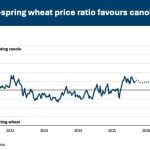High winds may dash the high hopes of some Red River Valley farmers who hoped to protect their homes and barns with sandbags and ring dikes.
Officials say more than 17,000 people left the flood-ravaged region last week as town after town along the Red River was evacuated. Some farmers moved livestock to higher ground or sold them early.
Many farms and houses on low-lying land are filling with the filthy cold black river.
But some farmers stayed behind, determined to stick with their livestock come hell or high water.
Read Also

Farmers urged to be grain-safe this fall
Working around grain bins comes with risk, from farmers falling to drowning in grain: Experts have five tips to help avoid grain-related accidents this harvest.
In the firehall at Rosenort, where about 20 people are left to keep an eye on the rural municipality of Morris, Art Cornelson said he knows of half a dozen farmers who plan to stay.
A mandatory evacuation order for the Red River Valley issued by emergency officials doesn’t apply to farmers, Cornelson said.
“If you’re high and dry and you can survive, you just don’t go for that,” he said in a phone interview April 28.
One egg-laying operation relies on a large boat run by commercial fishermen from Gimli to take its eggs out of the flooded region.
But Cornelson said he’s worried about one hog barn that’s surrounded by an earthen dike. Strong winds were gusting through the region Monday and waves were moving the earth.
“Should that dike not hold, it’s too late to get the hogs out,” he said.
“Right now they’re hanging in there and we’re probably going to be lifting a pump into his dike with a chopper and keep the water out that’s seeping in or coming over by waves.
“But if we fail to keep that one, that might be history.”
Manitoba Agriculture’s emergency co-ordinator estimated farmers moved out at least 60 percent of livestock in the flood’s path last week.
But Gus Wruck said some farmers didn’t believe the worst could happen.
“We’ve had an awful lot of reluctance from an awful lot of people to (move out livestock),” Wruck said.
“Consequently, we’ve got a few people caught in a trap. They may be required to get out without getting livestock out.”
Wruck said he has heard of some animals being lost in flash floods, but had no confirmed reports of lost livestock as of April 28.
When the river crests south of Winnipeg around May 5, officials expect water to cover almost 2,600 square kilometres. It will take several weeks for floodwaters to drain.
The river reached its peak at the southern end of the valley in the border town of Emerson on April 28, where a ring dike around the town was steady and holding.
The Red River floodway protects Winnipeg at the north end of the valley by controlling water levels as the river flows into the city. Excess water is diverted into a large crescent-shaped ditch south and east of the city. Some low-lying homes near the ditches are threatened.
Beyond Winnipeg, the river travels through Selkirk and into Lake Winnipeg.
At the northwest end of the valley last week, heavy equipment moved earth feverishly to extend a dike at Brunkild to prevent the flooded Red and Morris rivers from looping around and joining the La Salle River.
People in the towns of Sanford, Domain and La Salle and a large part of the rural municipality of MacDonald were waiting to see if the dike would hold or whether they would join the thousands of evacuees staying with friends, relatives and in Winnipeg hotels.














